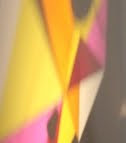(stupid blogger wouldn't allow this much text as a comment... so now it's a post...)
steve said...
... i'm not so sure i was surprised at finding myself working from a photograph as much as asking myself "how can i work from a photograph yet and still find freedom in the activity". of course it didn't hurt that the images i was obsessed with were black and white striped columns of marble, that do look a bit like a tramp art and minimal sculpture mash-up.
the conversation (between me and myself and the images in the postcards) wasn't about how i would replicate the image, but how to work with the images in a way that would cause me problems - because i'm using a different process of looking and making. in a way it was very important that these paintings came out of "conceptual failing" because i wanted the process to be different than using an "esoteric system or score" - so that these paintings would also seem different in process and visually as well. (i.e. the photographs would make the making of paintings more difficult, rather than easier)
certainly, over the past 8-10 years of looking at photographs, making collages, and thinking and writing about photographs, images are starting to weasel their way into my practice, and are certainly a huge huge interest in terms of my own inner conversations - but not so much in terms of the visual language of my paintings.
of course, other than collages, recognizable images are rarely the focus of the work... nonetheless, in the current shows there are 11 large scale ink drawings/impressions based on my body - two of which very much emphasize the human figure's presence (also a first). part of me thought not to show those two, but part of me wanted to allow them to create problems for people who think of me as specifically an abstract painter. (and yes, they are prominent in the LA show). but realistic images are present in many aspects of my work - with sound there are field recordings of recognizable sounds such as birds or cars or drums or planes, and with video/film there are figures or hands... and i think i would be inhuman to ignore the world as it is, even if i spend my life trying to make it into something that is my own.
so... on to conceptual failings...
first of all, i would say that artworks can be failures (and, they often are!), but a conceptual failing, i'm not so sure that is a bad thing. a bad idea or a failed idea or even a thin idea (which is how i would describe the fuel for these small paintings) can lead to a serious body of work. a thin or simple idea tends to offer freedom (sometimes too much, but sometimes very very necessary). and on the other hand, sometimes an incredibly brilliant idea can become a burden while making work, because in such cases the object has to conform to the idea - which is essentially the definition of illustration.
if the conceptual ideas are always placed at the top of the hierarchy of what gives an artwork meaning, we wouldn't need to experience things, as we could simply talk about the ideas surrounding an object without ever needing to see it, or experience it in person... and there are more aspects to an art experience than discussing the conceptual process that informed its making... (which sometimes functions as an excuse or justification for a failed object).
certainly, talking about ideas is interesting, but on some level i still believe in the old fashioned idea that "meaning" is something that evolves between a viewer, a maker, and an object - even duchamp suggested that the viewer was the component that completes a work of art and that it is sort of not art without a viewer's response (that means that even one of the greatest conceptual art minds of the 20th century also understood that people need to experience the works in person). it's funny, because we don't talk too much about the conceptual failings of a cowboy ballad, but we always seem to have a need to unpack an abstract painting...
obviously when one makes art in any medium, there is usually an impetus to take a thought or an image or a melody or a crumpled up piece of paper and to make something of it. sometimes it simply comes on the spur of the moment, sometimes from anger, from love, from ideas or concepts, nostalgia, sentiment, religious or political beliefs, tinkering, or even a photograph.
of course concepts are important - being able to think beyond the seed or the kernel, but some works do simply come from the gut, and they're no less powerful or moving because of it.








